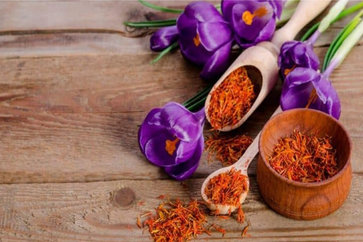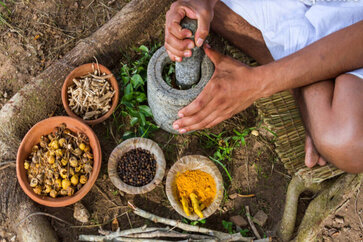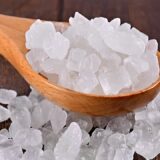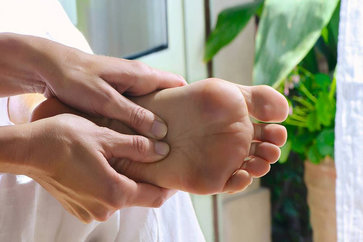Top Ayurvedic Solutions for Skin Candidiasis and Thrush
Fungal infections are quite common and, while generally not severe, can often cause significant discomfort and distress. Fungi, distinct from plants and animals, are microorganisms with some plant-like characteristics. They reproduce and spread through spores, which are tiny, seed-like structures.
Fungal infections are quite common and, while generally not severe, can often cause significant discomfort and distress. Fungi, distinct from plants and animals, are microorganisms with some plant-like characteristics. They reproduce and spread through spores, which are tiny, seed-like structures.
Fungi are ubiquitous and found all over the world, but their small size and inconspicuous nature often make them unnoticed. They typically become noticeable only when they cause symptoms like skin rashes. When fungi grow into a mycelium—a network of interconnected hyphae—they absorb water and nutrients, similar to plant roots.
On human skin or mucous membranes, fungi can lead to irritation and unpleasant symptoms such as burning or itching. The fungal plaques that develop on the skin are challenging to eliminate because they reproduce through spores. These spores are so tiny that they are invisible to the naked eye and can be resistant to certain chemical detergents and heat.
Fungi can persist on the skin for extended periods and become active when environmental conditions favor their growth. Below are some common fungal infections and their causes.
What is Candidiasis?
Candidiasis is an infection caused by the overgrowth of the fungus Candida albicans. This fungus is naturally present in small amounts in the mouth, skin, and gastrointestinal tract, along with other types of yeast and bacteria that usually keep it in check.
There are over 20 species of Candida, but Candida albicans is the most common cause of infection. Candidiasis often occurs when the immune system is weakened by factors such as stress, illness, or antibiotic use.
Yeast infections are more likely to affect individuals who are frequently in moist or wet conditions, such as those whose hands are often submerged in water, people who wear clothing that retains moisture, or children who suck their fingers. In infants, candidiasis can cause diaper rash, a type of dermatitis, due to the growth of Candida yeast in the skin folds.
Ayurvedic View on Candidiasis
Ayurvedic medicine, a traditional system of healing that originated in India over a thousand years ago, approaches health and disease through a holistic perspective that encompasses the mind, body, and spirit. In Ayurveda, treatments are aimed at restoring balance and wellness through dietary changes, herbal remedies, and spiritual practices.
Candida Overgrowth in Ayurveda:
- Terminology: In Ayurvedic terms, Candida is often referred to as a type of parasitic infection known as “krumi.” Rather than identifying Candida albicans as a specific pathogen, Ayurveda views it as part of a broader concept of parasitic diseases.
- Underlying Causes: Ayurveda does not pinpoint Candida as a single causative agent but considers it a manifestation of an underlying imbalance. Candida overgrowth is often seen as a symptom of “Agnimandaya,” which translates to “poor digestion” or “diminished digestive fire.”
- AMA and Digestive Imbalance: The Ayurvedic perspective attributes Candida overgrowth to poor digestion and assimilation of food. When digestion is compromised, it leads to the production of “AMA,” which are toxins formed from undigested or improperly processed food. These toxins can accumulate in the body and create a toxic environment conducive to Candida overgrowth.
- Pathophysiology: According to Ayurveda, AMA can enter the bloodstream or lymphatic system, spreading throughout the body and leading to various health issues. This toxic buildup disrupts the natural balance and promotes the growth of parasites like Candida.
Treatment Approach in Ayurveda:
- Dietary Changes: Ayurveda emphasizes improving digestion through dietary modifications. Consuming foods that are easy to digest, incorporating digestive spices, and avoiding heavy, processed, or improperly combined foods can help restore digestive balance.
- Herbal Remedies: Herbal treatments are used to address imbalances and support digestion. Herbs with anti-fungal, detoxifying, and digestive-enhancing properties are often prescribed to help manage symptoms and reduce AMA.
- Lifestyle Adjustments: Ayurveda also recommends lifestyle changes to support overall health and balance. This can include stress management, regular physical activity, and practices such as yoga and meditation to enhance overall well-being and digestive health.
- Detoxification: Purification processes, such as Panchakarma (a set of detoxifying treatments), may be employed to cleanse the body of toxins and restore balance.
In summary, Ayurveda views Candida overgrowth as a result of poor digestion and toxin accumulation rather than a singular infectious agent. The focus is on improving digestive health, detoxifying the body, and restoring balance through a holistic approach.
Common Fungal Infections
Here’s a list of some common fungal infections along with brief descriptions:
1. Ringworm (Tinea Corporis)
A highly contagious fungal infection that causes a red, circular rash with a clear center, giving it a ring-like appearance. It can affect the skin on various parts of the body, including the scalp (tinea capitis) and body (tinea corporis). The infection spreads through direct contact or by sharing personal items, and symptoms can include itching, scaly patches, and hair loss in the case of scalp involvement.
- Symptoms: Itchy, red, scaly patches; ring-shaped rash; hair loss in the case of scalp infections.
2. Athlete’s Foot (Tinea Pedis)
A common fungal infection that primarily affects the skin between the toes but can also spread to the soles and sides of the feet, known as athlete’s foot. It causes itching, burning, and peeling, and is often exacerbated by warm, damp environments like locker rooms or sweaty shoes. Individuals with diabetes or compromised immune systems are at higher risk.
- Symptoms: Itching, burning, redness, peeling, and cracking of the skin, particularly between the toes.
3. Jock Itch (Tinea Cruris)
This fungal infection affects the groin area, including the inner thighs and buttocks, commonly known as jock itch. It causes itching, redness, and a rash, and is often aggravated by sweating, tight clothing, or poor hygiene. It is more common in athletes and individuals who are overweight or have weakened immune systems.
- Symptoms: Itching, redness, and a rash with well-defined edges that can spread to nearby areas. The rash often has a ring-like appearance.
4. Nail Fungus (Tinea Unguium or Onychomycosis)
A fungal infection that affects the nails, often causing them to become discolored, thickened, and brittle. Known as onychomycosis, it can lead to pain and difficulty in nail growth, and is more common in individuals with compromised immune systems, poor circulation, or those who frequently expose their nails to moisture.
- Symptoms: Thickening, discoloration (yellow, brown, or white), and crumbling of the nails.
5. Candida Infection (Candidiasis)
Caused by the Candida species, often Candida albicans. This infection can occur in moist areas of the body, such as the mouth (oral thrush), genital area (vaginal yeast infections), and skin folds. It commonly affects individuals with weakened immune systems, diabetes, or those taking antibiotics, and can lead to symptoms like itching, soreness, and white patches.”
- Symptoms: Itching, redness, and discharge (in vaginal infections); white patches in the mouth; rashes in skin folds.
6. Tinea Versicolor (Pityriasis Versicolor)
Caused by an overgrowth of Malassezia yeast, it results in discolored patches on the skin, often appearing lighter or darker than the surrounding areas. This condition, known as pityriasis versicolor, is more common in warm, humid climates and can be exacerbated by sweating or oily skin.
- Symptoms: Patches of skin that are lighter or darker than the surrounding skin, which may be slightly itchy.
7. Seborrheic Dermatitis
Often linked to the Malassezia yeast, it causes a scaly, itchy rash primarily on oily areas of the skin like the scalp, face, and chest. This condition, known as seborrheic dermatitis, can also lead to dandruff and may flare up in response to stress or changes in weather.
- Symptoms: Red, flaky, or greasy patches on the skin; dandruff.
8. Histoplasmosis
A fungal infection caused by inhaling spores of Histoplasma capsulatum. It’s commonly found in soil contaminated with bird or bat droppings and can lead to respiratory issues or more severe complications, especially in individuals with weakened immune systems.
- Symptoms: Flu-like symptoms such as fever, cough, and chest pain; can be more severe in people with weakened immune systems.
9. Aspergillosis
Caused by the Aspergillus species of mold. It can affect the lungs and other parts of the body, leading to conditions like aspergillosis, which can be particularly dangerous for individuals with compromised immune systems or lung diseases.
- Symptoms: Respiratory issues, coughing up blood, fever, and chest pain. It can also cause sinus infections and systemic infections in immunocompromised individuals.
10. Cryptococcosis
Caused by the Cryptococcus species, often found in bird droppings. It can lead to lung infections or meningitis. People with weakened immune systems, such as those with HIV/AIDS, are particularly vulnerable to severe forms of the infection.
- Symptoms: Cough, chest pain, fever, and if it spreads to the brain, symptoms such as headache, fever, and neck stiffness.
Fungal infections are often managed with topical or oral antifungal medications, and good hygiene practices can help prevent their spread. For persistent or severe cases, seeking medical advice is essential.
Causes Of Common Fungal Infections
Here’s a detailed overview of the causes of some common fungal infections:
1. Ringworm (Tinea)
- Direct Contact: Contact with an infected person, animal, or contaminated objects (like towels or clothing) can spread the fungus.
- Indirect Contact: Fungal spores can be present in the environment, including on surfaces like floors and gym equipment.
- Animal Carriers: Pets, especially cats and dogs, can carry and transmit the fungus to humans.
- Environmental Exposure: Soil and other surfaces contaminated with fungal spores can also be sources of infection.
2. Athlete’s Foot (Tinea Pedis)
- Moist Environments: Fungal spores thrive in warm, damp environments such as public showers, swimming pools, and locker rooms.
- Contaminated Items: Using or sharing towels, socks, or shoes that are contaminated with the fungus.
- Sweaty Feet: Prolonged moisture from sweating or being in wet footwear can create a breeding ground for the fungus.
- Poor Foot Hygiene: Not keeping feet clean and dry increases susceptibility.
3. Jock Itch (Tinea Cruris)
- Warm, Moist Conditions: The infection thrives in the warm, moist areas of the body such as the groin and inner thighs.
- Sweat and Friction: Excessive sweating and friction from tight clothing can exacerbate the problem.
- Poor Hygiene: Infrequent washing and wearing unclean or non-breathable underwear can contribute to infection.
- Shared Items: Using contaminated towels or personal items.
4. Nail Fungus (Tinea Unguium)
- Moisture Exposure: Prolonged exposure to moisture, such as walking barefoot in public places or wearing damp shoes.
- Injury to the Nail: Trauma to the nail can allow fungi to enter and establish an infection.
- Poor Hygiene: Not keeping nails clean and dry can facilitate fungal growth.
- Shared Spaces: Walking barefoot in communal areas can increase risk.
5. Candida Infections (Candidiasis)
- Antibiotic Use: Disruption of normal bacterial flora by antibiotics can lead to an overgrowth of Candida.
- Immunosuppression: Conditions such as diabetes, HIV, or the use of immunosuppressive medications can increase susceptibility.
- Hormonal Changes: Hormonal fluctuations, such as those during pregnancy or with oral contraceptive use, can predispose individuals to infections.
- Moist, Warm Environments: Areas prone to moisture, such as the mouth (oral thrush), genital area, and skin folds are common sites.
6. Tinea Versicolor (Pityriasis Versicolor)
- Yeast Overgrowth: Caused by an overgrowth of Malassezia yeast, which is normally present on the skin.
- Hot, Humid Weather: Warm, humid conditions can promote the growth of the yeast.
- Oily Skin: An excess of skin oil can contribute to the growth of Malassezia.
7. Seborrheic Dermatitis
- Malassezia Yeast: Associated with an overgrowth of Malassezia yeast on the skin.
- Oily Skin: Conditions that increase skin oil production can exacerbate the problem.
- Stress and Weather: Stress, cold weather, and changes in season can trigger or worsen symptoms.
8. Histoplasmosis
- Exposure to Bird or Bat Droppings: Fungal spores from soil contaminated with droppings can be inhaled.
- Soil Contamination: Working with or being near soil contaminated with the spores can also be a risk factor.
9. Aspergillosis
- Inhalation of Spores: Spores from Aspergillus fungi can be inhaled from contaminated environments like soil or decaying vegetation.
- Immunocompromised State: Individuals with weakened immune systems are more susceptible to severe infections.
10. Cryptococcosis
- Inhalation of Spores: Spores from Cryptococcus neoformans can be inhaled from soil or bird droppings.
- Immunocompromised State: People with weakened immune systems, such as those with HIV/AIDS, are at higher risk.
General Prevention Tips:
- Good Hygiene: Regular washing, thorough drying, and changing out of wet clothes promptly.
- Avoid Sharing Personal Items: Don’t share towels, socks, or shoes.
- Keep Environments Dry: Use antifungal powders or sprays if needed in moist areas.
- Prompt Treatment: Addressing infections early can prevent their spread and complications.
Understanding these causes can help in taking preventative measures and seeking appropriate treatment when needed. If you have persistent or severe symptoms, consulting a healthcare provider is essential.
Different Types Of Candidiasis
1. Oral Candidiasis (Oral Thrush):
- Description: This infection affects the mouth and throat, often seen in young children, infants, and the elderly. It is characterized by painless white or cream-colored patches on the tongue, inner cheeks, and sometimes the throat.
- Symptoms: White patches in the mouth, redness, and soreness. It is often recurrent.
2. Oral Moniliasis (Thrush):
- Description: Commonly known as thrush, this type of candidiasis can also manifest as a painful infection. Although often associated with vaginal yeast infections, it can occur in the mouth and throat as well.
- Symptoms: Painful white lesions on the tongue and inside the mouth, difficulty swallowing. It is frequently seen during pregnancy or following antibiotic treatment.
3. Balanitis:
- Description: This infection affects the glans (head) of the penis and can occur at any age, though it is more common in boys under four years old and can also affect adult males under certain conditions.
- Symptoms: Pain, redness, and inflammation on the head of the penis. It can cause discomfort and swelling.
4. Systemic Candidiasis (Invasive Candidiasis):
- Description: This serious and potentially life-threatening type of candidiasis occurs when Candida enters the bloodstream and spreads to various organs. It can be caused by environmental fungi, overgrowth of Candida, or other factors.
- Symptoms: This infection can affect multiple body systems, leading to symptoms like fever, chills, and signs of organ dysfunction. It can contribute to conditions such as adult acne, arthritis, and heart disease. Systemic candidiasis involves the release of mycotoxins (toxic substances) produced by fungi, which can impact overall health.
Each type of candidiasis requires appropriate treatment and management. For mild cases, topical antifungal treatments may be sufficient, while more severe or systemic infections may require systemic antifungal medications and medical intervention.
Ayurvedic Treatment For Candida
In Ayurveda, the management of Candida overgrowth is rooted in the understanding that poor digestion, termed “agnimandaya”, leads to the production of AMA (toxins), which accumulates in the digestive tract and contributes to the imbalance. Here’s how Ayurveda approaches the treatment of Candida:
Understanding the Imbalance:
- Agnimandaya (Poor Digestion): Poor digestive fire (Agni) results in incomplete digestion of food, leading to the formation of AMA.
- AMA Accumulation: AMA, the toxic byproduct of undigested food, accumulates primarily in the lower digestive tract, including the small and large intestines.
- Disruption of Normal Flora: AMA can disrupt the balance of intestinal flora, allowing Candida yeast to proliferate unchecked.
Impact on Dhatus:
The accumulation of AMA and the resulting Candida overgrowth can affect the seven dhatus (tissues) in the body:
- Rasa (Plasma)
- Rakta (Blood)
- Mamsa (Muscle)
- Medha (Fat)
- Majja (Nervous Tissue)
- Asthi (Bone)
- Sukra (Sperm and Ovum)
When these dhatus are damaged, their functions deteriorate, leading to reduced vitality, poor health, and impaired reproductive functions. Sukra, being the final product of the digestive process, is crucial for vitality, immunity, and longevity. Proper management of Candida is essential to restore balance and function to these dhatus.
Ayurvedic Treatment Strategies:
Dietary Adjustments:
- Improve Digestion: Consume foods that are easy to digest and support digestive health. Include spices like ginger, cumin, and turmeric that enhance Agni (digestive fire).
- Avoid Heavy Foods: Steer clear of foods that are heavy, oily, or difficult to digest, as they contribute to AMA formation.
- Follow a Balanced Diet: Incorporate a diet that supports balance and prevents the accumulation of AMA. Emphasize fresh, whole foods, and avoid processed or sugary foods that can exacerbate Candida growth.
Herbal Remedies:
- Anti-fungal Herbs: Use herbs with natural antifungal properties, such as Neem, Tulsi (Holy Basil), and Pau d’Arco to combat Candida overgrowth.
- Digestive Enhancers: Herbs like Triphala and Pippali support digestion and help reduce AMA.
- Detoxifying Herbs: Herbs like Haritaki and Coriander can aid in the detoxification process and help clear AMA from the body.
Lifestyle Changes:
- Hydration: Drink plenty of warm water to help flush out toxins and support digestion.
- Regular Exercise: Engage in regular physical activity to promote healthy digestion and overall well-being.
- Stress Management: Practice stress-reducing techniques such as yoga, meditation, and breathing exercises to maintain balance and support digestive health.
Detoxification:
- Panchakarma: Consider undergoing Panchakarma, an Ayurvedic detoxification process, to cleanse the body of AMA and restore balance. This may include treatments like Virechana (therapeutic purgation) or Basti (medicated enema).
Supportive Therapies:
- Abhyanga (Oil Massage): Regular oil massages can help balance Vata dosha and support the detoxification process.
- Shirodhara: This therapeutic treatment involves pouring warm oil over the forehead to calm the mind and support overall health.
By addressing the root cause of Candida overgrowth—poor digestion and AMA accumulation—Ayurvedic treatments aim to restore balance, enhance digestive health, and support overall vitality. Consultation with an Ayurvedic practitioner is recommended for personalized treatment and guidance.
Vata Type Candida
In Ayurveda, an imbalance in the Vata dosha can contribute to Candida overgrowth. The Vata dosha, which is characterized by qualities like dryness, coldness, and irregularity, can be aggravated by certain dietary and lifestyle factors, leading to the production of AMA (toxins) and subsequent health issues such as Candida infections.
Causes of Vata-Type Candida:
- Diet: Excess intake of spicy, bitter, and astringent foods can aggravate Vata. Foods that are difficult to digest, such as sugar, nuts, and dairy products, contribute to AMA formation.
- Lifestyle: Consuming cold foods, excessive travel, irregular eating patterns, and poor sleep habits can disrupt natural bodily functions and increase Vata imbalances.
- Symptoms: Vata aggravation often presents with dryness of the skin, mood swings, nervousness, and difficulty coping. Digestive issues like gas, constipation, bloating, and fluctuating energy levels may also occur.
Recommended Diet for Vata-Type Candida:
Avoid AMA-Producing Foods:
- Dairy Products: Reduce or avoid dairy, which can exacerbate mucus production.
- Sugar and Bread: Limit intake as these can contribute to fungal growth.
- Cold and Raw Foods: Avoid consuming cold and raw foods, as they can increase Vata and suppress digestion.
Hydration:
- Hot Water: Drink hot water regularly throughout the day. Aim for eight to ten glasses per day, mixing hot water with lemon for added benefits.
- Avoid Cold Beverages: Steer clear of cold drinks to help balance Vata.
Meal Guidelines:
- Large, Relaxing Meals: Have a substantial meal and a hot soup for dinner to support digestion.
- Moderate Fresh Fruits: Fresh fruits can be consumed in moderation, but avoid fruit juices.
Spices and Herbs:
- Use in Cooking: Incorporate Vata-balancing herbs and spices like basil, hing (asafoetida), ginger, garlic, and ajwain (carom seeds) into your meals to aid digestion and combat fungal growth.
Probiotics:
- Moderation: Consume probiotics in small amounts, such as fresh yogurt (dahi) or coconut milk yogurt. These can help support healthy gut flora and digestion.
By adhering to these dietary and lifestyle recommendations, individuals with a Vata-type Candida imbalance can help manage their symptoms and support overall digestive and immune health.
Consulting with an Ayurvedic practitioner can provide personalized guidance and adjustments based on specific needs and conditions.
Pitta Type Candida
When the Pitta dosha is aggravated, it can disrupt the digestive fire (Agni) and lead to various health issues, including Candida infections. Pitta imbalances are often characterized by excess heat and acidity, which can affect the liver and blood, contributing to Candida overgrowth.
Causes of Pitta-Type Candida:
- Diet: Excessive intake of fatty, sugary, and spicy foods can aggravate Pitta, leading to imbalances that affect digestion and overall health.
- Symptoms: Pitta imbalances often present with symptoms like acidic indigestion, heartburn, irritability, abdominal distension, joint pain, a yellowish complexion, loose stools, high body temperature, and excessive thirst.
In cases where Pitta and Vata are both involved, you may also experience symptoms such as gas and bloating, indicating a mixed Vata-Pitta condition.
Recommended Diet for Pitta-Type Candida:
Cooling and Balancing Foods:
- Fresh Vegetables: Include raw leafy greens and fresh vegetables in your diet to help cool the body.
- Fruits and Vegetables: Focus on fruits and vegetables that are bitter in taste to counteract Pitta.
- Avoid: Refrain from consuming fruit juices and sugary foods, which can aggravate Pitta.
Natural Antibiotics:
- Coconut Oil: Start with a small amount (1/2 teaspoon) and gradually increase to up to two tablespoons per day. Coconut oil has natural antifungal properties that can help manage Candida.
- Neem Oil: Use Neem oil for its detoxifying effects, which can cleanse the liver and blood, supporting overall health and helping to manage Candida.
Dietary Adjustments:
- Cooling Spices and Herbs: Use herbs and spices that have a cooling effect on the body, such as cilantro, fennel, and cardamom, to help balance Pitta.
By following these dietary recommendations and incorporating natural remedies, individuals with Pitta-type Candida can help restore balance and support their overall well-being.
For a comprehensive approach, consider consulting with an Ayurvedic practitioner who can tailor the treatment plan to your specific needs and health conditions.
Kapha-Type Candida
In Ayurveda, Kapha dosha is characterized by qualities such as heaviness, coldness, and dampness. When Kapha is aggravated, it can lead to various issues, including Candida infections.
This imbalance often results from excessive intake of heavy, oily, and cold foods, as well as overeating and poor digestion.
Causes of Kapha-Type Candida:
- Diet: Overeating and consuming heavy, oily, and cold foods such as sugar, bread, and pasta can aggravate Kapha. This leads to the production of AMA (toxins) due to impaired digestion.
- Symptoms: Kapha imbalances may present with symptoms like low immunity, water retention, swollen glands, fatigue, excessive sleep, and a heavy state of mind. Other signs include nausea and vomiting.
Recommended Diet for Kapha-Type Candida:
Incorporate Hot and Spicy Foods:
- Herbs and Spices: Use hot and stimulating spices like black pepper, curry, ginger, cloves, and pepper to stimulate digestion and counteract Kapha.
Avoid Mucus-Forming Foods:
- Mucus-Forming Foods: Steer clear of foods that produce excess mucus, such as dairy products and refined sugars.
- Opt for: Bitter and astringent foods that help reduce mucus, including leafy greens like spinach, kale, and dandelion, as well as other vegetables like cabbage and asparagus.
Healthy Eating Habits:
- Avoid Heavy Foods: Limit intake of fatty, greasy foods, and sugar. Focus on lighter, easier-to-digest foods like cereals and vegetables.
- Moderate Portions: Eat smaller, more frequent meals to avoid overeating and aid digestion.
By adhering to these dietary and lifestyle recommendations, individuals with Kapha-type Candida can help manage their symptoms and restore balance to their dosha.
For personalized guidance and a comprehensive treatment plan, consulting with an Ayurvedic practitioner is recommended.
Note: You should apply all-natural remedies to a certain stage, but beyond that, you should consult a doctor to cure the problems before it gets worsen.
In today’s active lifestyle, anyone can get a fungal infection and it is quite common. There are many herbal remedies that can destroy the fungi which cause infection and reduce the intensity of symptoms.
References:
- Chronic Fungal Infections of the Skin in Children and its Response to the Ayurveda Treatment:A Case Report(1)
- AYURVEDIC REMEDIES ON VAGINAL CANDIDIASIS(2)
- Ayurvedic management for Shleshmiki Yoni Vyapada w.s.r to Vaginal Candidiasis(3)
- Anti-candidal Effect of Ocimum sanctum: A Systematic Review on Microbial Studies(4)


























One of the important ayurvedic treatment. Thanks for sharing with us
It is estimated that three in four people worldwide suffer from a yeast infection and sufferers continue to grow more, This means that conventional drugs are getting less and less effective causing patients to have another look at natural cures for yeast infections.